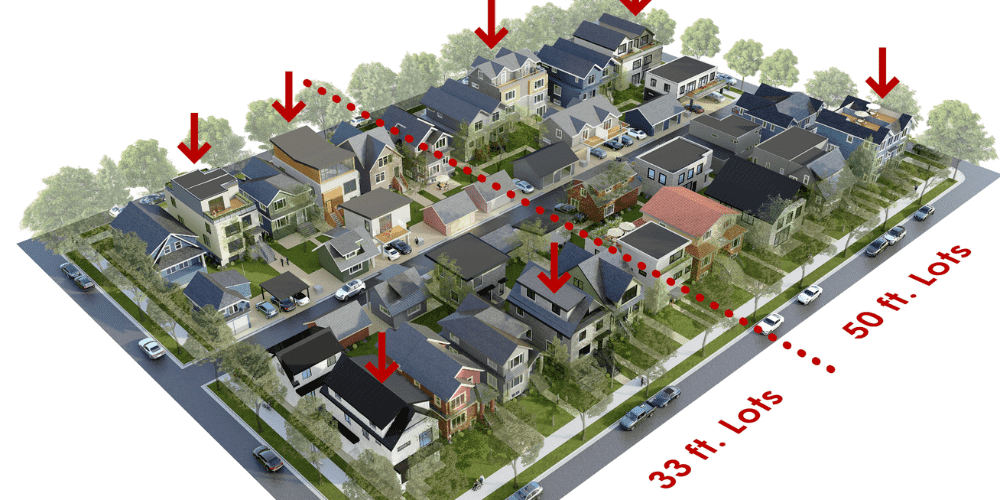Canadian real estate is being reshaped by the’missing middle housing’

Advertisement: Click here to learn how to Generate Art From Text
The term “missing middle” has become as common in today’s real estate vocabulary as “a hot market”The following are some examples of how to use “location, location, location.” Cliches often have some truth in them — and in the case of the “missing middle,” it’s gaining traction in the Canadian real estate market in part due to the rise of a newer property type: multiplexes.
Changes in B.C. Changes in B.C.
Multiplexes are homes that have multiple units on what was previously a lot for a single detached house. They can vary between two and eight units.
In 2023, British Columbia made amendments to their Housing Statutes (Residential Development) Amendment Act — more commonly referred to as “Bill 44.” That same year, Toronto’s city council adopted its own Official Plan Amendment and Zoning Bylaw Amendment to allow multiplexes throughout the city.
Jasmine Cracknell Young is the vice president for market advisory at Zonda. She noticed that the number of multiplex listings has risen dramatically in Toronto since these amendments. According to the Toronto Regional Real Estate Board (TRREB), in 2023 there were 115 listings and in 2024, 168 listings — a 46.1 per cent increase.
“I think because housing has become such a hot topic, we have all levels of government finally talking about it because they realize the crisis that we’re in,”She makes a comment.
The following are some of the ways to get in touch with each other ‘tiny part of the market’Legislation could be too limited
Chris Spoke, a builder and developer at Toronto Standard, has witnessed first-hand the impact these legal changes have had on housing projects. Personally, he doesn’t believe the legislation goes far enough.
“So we have five residential zones in Toronto. Two of those residential zones do support multi-unit housing, but the zoning bylaws paired with the city’s Official Plan and the language of it is if there’s any new development within the neighborhood’s designation, it has to respect and reinforce the existing physical character.
(This) means that even if the zoning technically allows for multi-unit housing, if it’s not consistent with the existing physical character, then you’re not going to get past this test,”Spoke explains. “We’ve still not seen a lot of activity because I think the multiplex bylaw doesn’t go far enough in terms of the permissions. So it’s still like a tiny part of the market.”
Major Streets Study: Optimism, opposition and other perspectives
Spoke is optimistic about the future of multiplexes, especially in Toronto. This is due to the momentum created by the Major Streets Study. “focuses on permitting gentle density — missing middle housing — on major streets in low-rise neighbourhoods across Toronto.”
“These are the major arterials in the city that have bus routes on them,”Adds Spoke. “So this also opened up a new scale of development in parts of the city where it was not legal before.”
These policies are not without opposition. Traffic is a major concern for residents when it comes the Major Streets Policy.
“It’s always traffic,” shares Cracknell-Young. “They just think it’s taking up road space.”
Bill 44 in B.C. Bill 44 in B.C. addresses these concerns by preventing new vehicles from entering neighbourhoods entirely in some cases. Transportation AccessibilityIt is expected to play a key role in the development and construction of multiplex housing.
Ottawa: Multiplex increases are expected to be approved after the bylaw in 2025
Nachiket Kulkarni is an architect with Architrix Studio. He has worked on multiplexes in Vancouver as well as Ottawa, where he lives now.
“Ottawa would be two or three years behind Vancouver when it comes to that change,”He says. “So whatever happens in Vancouver right now, the same change would be in Ottawa two or three years down the line in terms of multiplexes.”
Kulkarni, who has observed a shift in Ottawa towards multiplex development, believes that this trend will continue to grow after December 2025 when the new zoning ordinance is expected to be approved.
“In Ottawa, they’ve consolidated the number of zones into just six zones now, just like Vancouver did,” adds Kulkarni.
The City of Vancouver introduced a new zoning design in October 2023. “R1-1,”Also known as “Residential Inclusive.”This was implemented to replace and simplify previous zoning structures, which included RS (One Family Dwelling), RT(Two Family Dwelling), and RM(Multiple Dwelling).
And similar to Toronto and Vancouver, Ottawa’s changes will also aim to reduce parking requirements.
‘Citizen developers’On the rise
Spoke believes the new changes to multiplexes could lead to a phenomenon he calls “citizen developers:”Home builders, general contracting firms and even ordinary homeowners can all actively participate in creating new housing opportunities.
“Multiplexes offer a form of development that’s accessible to people who haven’t worked professionally as developers,”Spoke says
While multiplexes won’t solve our housing problems over night, they offer a way to think about densities in a more nuanced fashion.
“I think it’s a really great product form. You can have multiplexes go into existing communities and have people of different incomes and demographics able to access some of the best communities that we have,” says Cracknell-Young. “To stop the sprawl and have more people in our existing communities where it’s possible … I hope that we will see more of them.”
Image: ShapeYourCity.ca

‘ Credit:
Original content by realestatemagazine.ca – “How ‘missing middle’ housing is reshaping Canadian real estate”
Read the complete article at https://realestatemagazine.ca/multiple-perspectives-on-multiplexes-how-missing-middle-housing-is-reshaping-canadian-real-estate/




